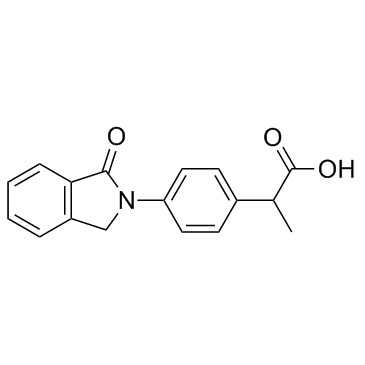Indoprofen

Indoprofen structure
|
Common Name | Indoprofen | ||
|---|---|---|---|---|
| CAS Number | 31842-01-0 | Molecular Weight | 281.30600 | |
| Density | 1.308g/cm3 | Boiling Point | 511.3ºC at 760mmHg | |
| Molecular Formula | C17H15NO3 | Melting Point | 213-214° | |
| MSDS | Chinese USA | Flash Point | 263ºC | |
| Symbol |


GHS06, GHS08 |
Signal Word | Danger | |
|
Evaluation of amino acid ester-based ionic liquids as buffer additives in CE for the separation of 2-arylpropionic acids nonsteroidal anti-inflammatory drugs.
Electrophoresis 35(18) , 2573-8, (2014) The aim of the present study is the CE performance evaluation for the separation of 2-arylpropionic acid nonsteroidal anti-inflammatory drugs. In particular, the separation of indoprofen, carprofen, ketoprofen, ibuprofen, and flurbiprofen was obtained by supp... |
|
|
A chiral separation strategy for acidic drugs in capillary electrochromatography using both chlorinated and nonchlorinated polysaccharide-based selectors.
Electrophoresis 35(19) , 2807-18, (2014) A generic chiral separation strategy for the analysis of acidic compounds in CEC is proposed in completion of an earlier defined strategy for nonacidic compounds. The screening step of this strategy uses a 45 mM ammonium formate (pH 2.9)/ACN (35/65, v/v) mobi... |
|
|
Enantiomers separation by nano-liquid chromatography: use of a novel sub-2 μm vancomycin silica hydride stationary phase.
J. Chromatogr. A. 1381 , 149-59, (2015) A novel sub-2 μm chiral stationary phase (CSP) was prepared immobilizing vancomycin onto 1.8 μm diol hydride-based silica particles. The CSP was packed into fused silica capillaries of 75 μm i.d. with a length of 11 cm and evaluated by means of nano-liquid ch... |
|
|
Species-dependent binding of tocainide analogues to albumin: affinity chromatography and circular dichroism study.
J. Chromatogr. B. Analyt. Technol. Biomed. Life Sci. 968 , 69-78, (2014) A series of novel tocainide analogues were characterized for their HSA and RSA binding, by using high-performance liquid affinity chromatography (HPLAC) and circular dichroism (CD). In this HPLAC study, HSA and RSA were covalently immobilized to the silica ma... |
|
|
Flavonoids from each of the six structural groups reactivate BRM, a possible cofactor for the anticancer effects of flavonoids.
Carcinogenesis 35(10) , 2183-93, (2014) Flavonoids have been extensively studied and are well documented to have anticancer effects, but it is not entirely known how they impact cellular mechanisms to elicit these effects. In the course of this study, we found that a variety of different flavonoids... |
|
|
Singlet oxygen scavenging activity of non-steroidal anti-inflammatory drugs.
Redox Rep. 13(4) , 153-60, (2008) It has long been known that singlet oxygen ((1)O2) is generated during inflammatory processes. Once formed in substantial amounts, (1)O2 may have an important role in mediating the destruction of infectious agents during host defense. On the other hand, (1)O2... |
|
|
Mechanism of allergic cross-reactions--I. Multispecific binding of ligands to a mouse monoclonal anti-DNP IgE antibody.
Mol. Immunol. 28(6) , 641-54, (1991) A recently developed solid-phase binding assay was used to investigate the specificity of ligand binding to a mouse monoclonal anti-dinitrophenyl IgE [IgE(aDNP)]. All DNP-amino acids, that were tested, inhibited the binding of radio-labeled IgE(aDNP) to DNP c... |
|
|
Phototoxicity of non-steroidal anti-inflammatory drugs demonstrated in vitro by a photo-basophil-histamine-release test.
Photodermatol. 4(2) , 73-8, (1987) The phototoxic activity of the non-steroidal anti-inflammatory drugs (NSAID) acetylsalicylic acid, benoxaprofen, carprofen, diclofenac, indoprofen, ketoprofen, tiaprofenic acid, and of thiophene, a heterocyclic ring structure of the tiaprofenic acid molecule,... |
|
|
Evidence of a central component in the analgesic effect of indoprofene.
Gen. Pharmacol. 20(4) , 519-24, (1989) 1. The central nervous system effects of the analgesic antiinflammatory drug, indoprofene were studied. 2. CNS effects were found using EEG in rats and cats. 3. Evoked cortical potentials were studied in cats, and evoked activity in ventroposterolateral thala... |
|
|
Indoprofen upregulates the survival motor neuron protein through a cyclooxygenase-independent mechanism.
Chem. Biol. 11(11) , 1489-93, (2004) Most patients with the pediatric neurodegenerative disease spinal muscular atrophy have a homozygous deletion of the survival motor neuron 1 (SMN1) gene, but retain one or more copies of the closely related SMN2 gene. The SMN2 gene encodes the same protein (S... |